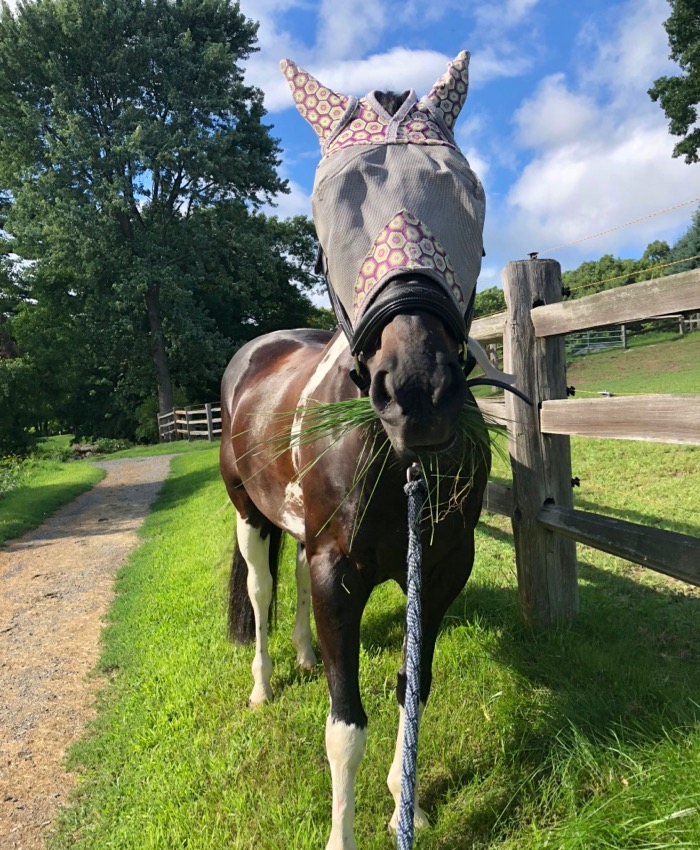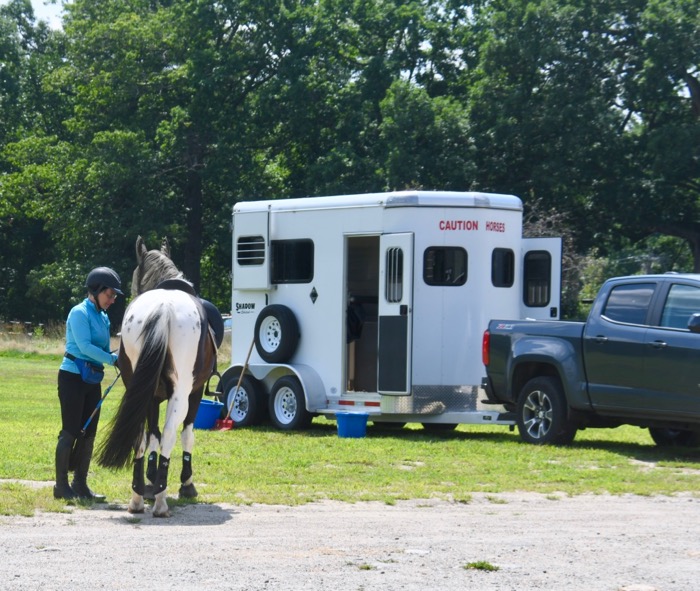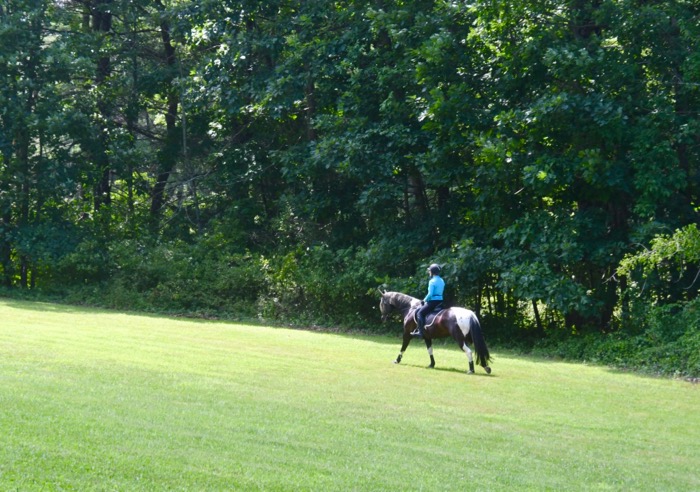My work with clients and their horses is ostensibly about teaching the humans how to ride, or the equines new behaviors. But underneath that, before that training can start, I need both horse and rider to be in a calm and confident place. Whether it’s the off-track thoroughbred learning how to move in a ring instead of on the racetrack, or a little Quarter Horse mare who panics out of sight of the barn, there is an emotional component to the work that we do.
My clients usually call me in when there is overt drama – a gelding that balks on the trail, and then spins and bolts for home, or the mare that only has one speed under saddle. But I can’t ask an ex-race horse to do a cadenced trot around the ring if she’s anxious and bracing against her rider. I can’t ask a trail horse to stand quietly facing home if the barn is the only place that she wants to be.
Some horses look perpetually tense, but I can always find a moment of calm to start from. It’s usually fleeting and very, very small. It might be a quiet breath, a head that comes down an inch, a slight turn of the eye to me, or an ear that swivels forward. It’s rare that the owner sees these things. They’ve got too much worry and history wrapped up in the horse, and too much desire for change. But once we switch the focus from the big drama to the small breath, everything improves.
When you can see the calm, you also see the tense. Then, and only then, can you develop feel and timing. When you watch the best trainers, it seems as if there’s no conflict with their animals, and all movement flows. But, in actuality, that trainer is making second-by-second decisions about when to ask and when to wait.
Take the example of what seems like a simple thing that you do with your horse – hand-grazing. Is there a lot of tugging and being pulled around? There doesn’t have to be if you communicate what you want the horse to do (let’s go here, or get your head up, or time to go back to the barn) when the horse is in a mental place that is calm and can tune into you.
Last week, Tonka and I went to a horse show. He was gone all day and hadn’t had any turnout, so I took him for a hand-graze when we got back home. All of the other horses at the barn were in their stalls. That put Tonka on alert. He wasn’t terribly worried, but a horse on his own is always more watchful.
Even when wearing a
Auto Amazon Links: No products found.
It’s clear that when he stops eating, that he’s scanning the environment to make sure it’s safe. But there’s so much else going on! Notice how the tempo of his breathing changes before he stops chewing. The flare in his nostrils. See the tension in his neck near his head? How his ears seem more erect?

When it was time to go back to the barn, I carefully chose my moment.

I got it when Tonka swung his head and looked at me to check in with what I was doing. In another second, he would have looked back across the fence, but I slipped in a let’s go. It’s a verbal cue that’s been highly reinforced in the past. It signals that we are now going to walk calmly elsewhere.
So, on a loose lead rope, with a relaxed demeanor, Tonka and I walked back to the barn.
On Friday, I trailered Tonka to a state park to go for a trail ride. There were two other horses at the parking area. Tonka checked them out, then looked at me as if to ask what did I think?

We agreed that they weren’t important. Before riding, I let Tonka tell me where he wanted to graze. Note that although he’s leading, he’s not pulling.

Sometimes I make suggestions. I thought he’d like to see what was at the edge of the field. He thought it tasty, but being so near the tall corn, and not knowing what was beyond, made him nervous.

I could tell that he didn’t feel entirely safe by how he was chewing and stopping, like in the video. Instead of getting used to this place, his muscles told me that he was getting more tense. So I decided to move him back to his comfort zone, the trailer. When a horse is quivering and on alert like this, pulling him away can make him more nervous. So I put my hand on his neck and said his name. For a split second, Tonka relaxed and turned his head towards me. That’s when I asked him to walk away. Start from calm, and that calm builds. Even if the calm is less than a full breath.
This attentiveness to those moments continued when I tacked up. I don’t tighten the girth unless he’s standing still and ready. I wait for this calm, I don’t cue it. I want my horse to recognize his own steady breaths, and have inner motivation to build on them. Horses are designed to spend hours of the day in a relaxed state, slowly moving while grazing companionably with friends. I want to bring that mental state to our domesticated life together.

Those very, very small moments of calm can lead to the big ones like this. Rewarding for both of us.



This is really, really helpful Terry. You are so right that the owner (me) has great trouble accurately and sensitively spotting these details and these changes. So yes, Milly and I have sometimes been that couple that you see having a tug of war when hand-grazing. So I’ll be practising what you describe, about waiting for that instant of calm and building on it….
Wonderful that this helped! Let me know how it goes. I love updates.
Guess I’ve been doing this, waiting for the moment of calm, for some time, but you have a way of explaining it that I can’t put in words. It’s always good to be reminded of these kind of techniques, as sometimes I do get impatient.
Impatience is part of being human 🙂
Thank you so much. This is an excellent and helpful article. Thank you particularly for the example of choosing your timing to help the request to be easily accepted. I really appreciate and enjoy your posts.
Thank you for your comment! It helps my writing to know what resonates with my readers.
A great exercise in being in the moment giving great results with Tonka and I smile thinking the same technique can be applied to many things in life, waiting for the right moment…
Is Steve going regularly tp your contests ?
Love reading your posts !
Agreed that this is applicable to so much in life. All of those great photos of me on Tonka are taken by Steve. It’s great to have his help and company at the shows!
This is wonderful. So very true. Its a journey but when you patiently wait and receive these calming signals and you recognise them and build on them the magic begins. You have put into words to well and great read. thankyou.
Thank you for your comment, Natalie. You’re right – magic and patience are interlaced!
My five year old normally laid back mare sideways spooks occasionally when I ride far out in the field. I have just been taking her off property to arenas and other friends houses and she becomes on high alert. If I keep taking her to new places and let her know it’s ok will she become the seasoned horse that hardly spooks with the more experience she has.
It makes sense that she goes on alert at new places. Alert is okay. Tense and panicked is not. The question is, is there anything you can do to get her to relax? It would help, at first, to have a horse friend along to give her confidence. It also helps to go to new places, but stay below threshold. You might want to go to a new place and simply hang out with a pile of hay. Tack up, walk around, go home. It’s not simply the number of experiences, but also the quality. If you do that, then yes, she should handle those situations without fear. Since you already know she can be laid back at home, you know she has it in her.
It’s never easy, but it is worth it 🙂
Thank you ! Yes the first Time I took her out I walked her away from her buddy to the creek and she panicked when someone was walking down the hill it was late in the evening new horses going everywhere she eventually relaxed when I brought her friend from home and walked her around. The side jumps have gotten me off so I think taking her to new places and having those good experiences is gonna help her realize everything is ok. I’ve also been doing your clicker training that I learned from your lecture at equine affaire.
Those side jumps are difficult to stay on. Try, instead of aiming for one place, circling around and moving the circle closer. When things are going well, instead of asking for a little more, do less and go home. Sounds like you’re on the right track!
Once they spook with sidejumps is that always their way of spooking
Not in my experience. Those side jumps happen when they’re suddenly scared, like when a pheasant flies out from the hedge. (I’ve had that happen a few times!) Spooking is dangerous for the horse – they could jump into a hole, etc – so they’d rather not be so dramatic. With confidence a horse might startle, but not move their feet much.
Great! She is young gonna keep taking her places with her buddy horse and lots of praise and treats !
With my young 5 year old mare that has only been off property a few times she has been very alert and at times very dancy at almost a side jump so I ky he her where she canters quite a bit willingly and when I feel her wanting to slow we slow and walk around more and when I see she lowers head and relaxes I cluck and treat. I haven’t been riding every single time because I feel the whole lesson is teaching her that new places are ok and I don’t feel safe riding and don’t want to add too much on her.
Five is very young! She might not even be fully physically mature. Do interesting things at home, too. Walk her over poles, over uneven ground. Let her explore and gain confidence. Take your time, and enjoy the process.